#vaccinium ovatum
Text
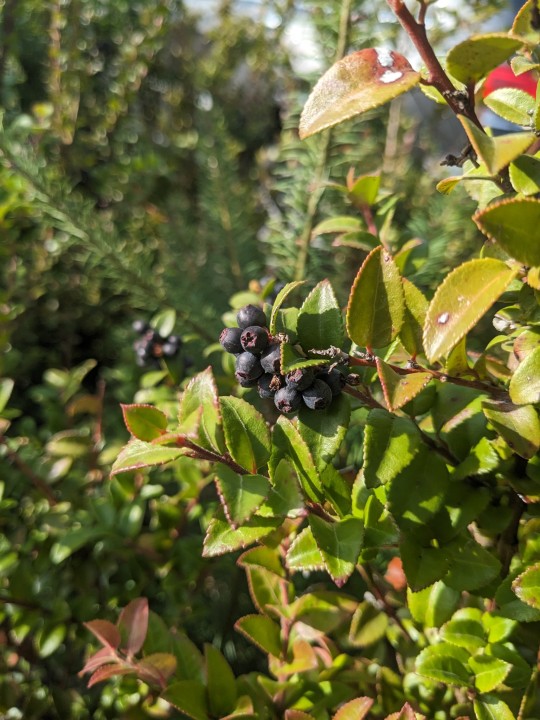
Vaccinium ovatum eith huckleberries right now :'3
13 notes
·
View notes
Text

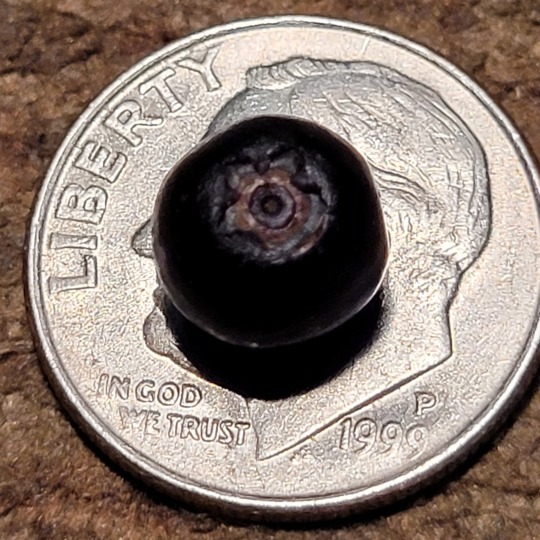
.
Meet and Greet Vaccinium ovatum. A fiddly little delicacy that ripens in the fall. This is my first harvest of the year for this berry and by the time I get enough to fulfill my annual need the season will be over.
It is wonderful as a garnish on a green salad, goes well in pancakes, scones or muffins and is 1/4 +/- of my annual juice blend. I need about 2 gallons to finish filling my juice jugs.
The berry it's self acts a little different in the freezer. At 0 Deg. F / -17.7 Deg. C it still looks a little wet. I assume it is the sugars in the berry but don't know but it makes it easy to get a small hand full out for my salad.
It grows in low costal situations from the Redwoods north into Canada that I know of. Probably a little further south maybe a little further north into the Alaska pan handle, I'm not fully sure.
.
#oddman-the-oldman#photographers on tumblr#annual berry juice#berry pickers on tumblr#vaccinium ovatum
8 notes
·
View notes
Text

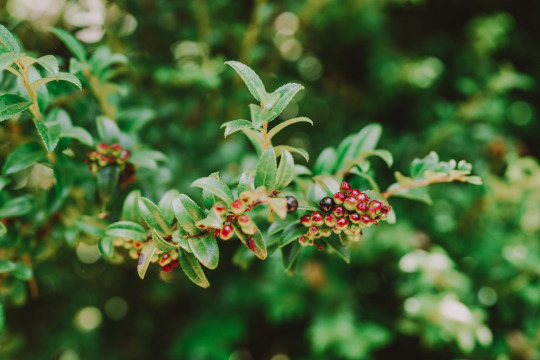
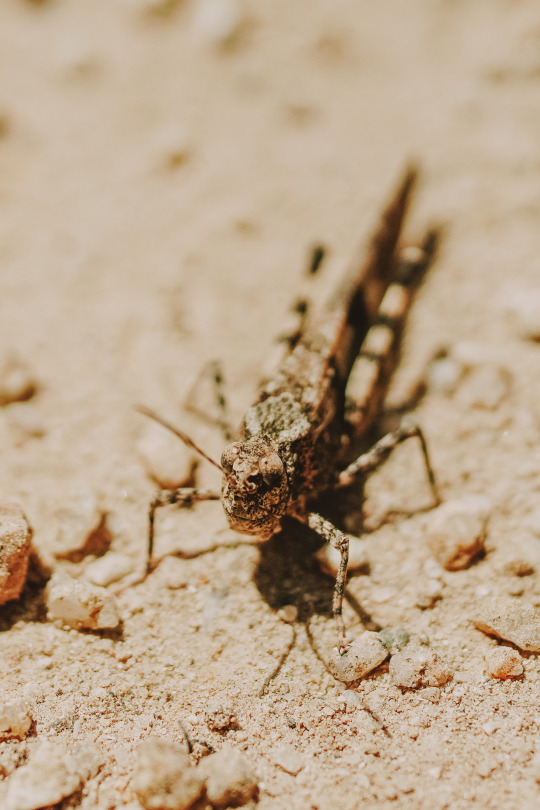

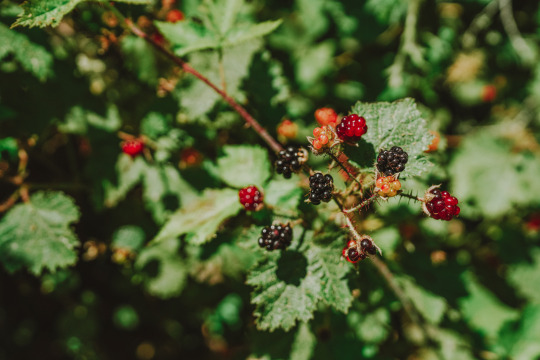
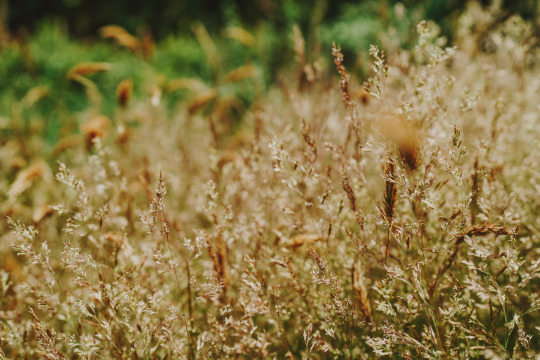

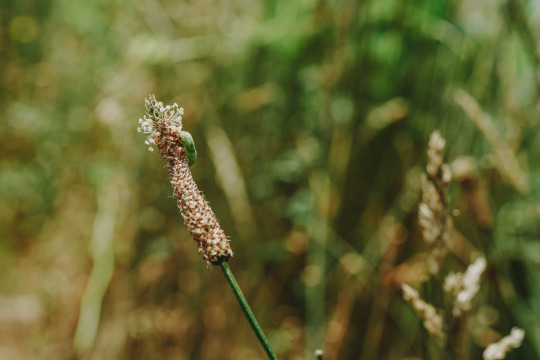
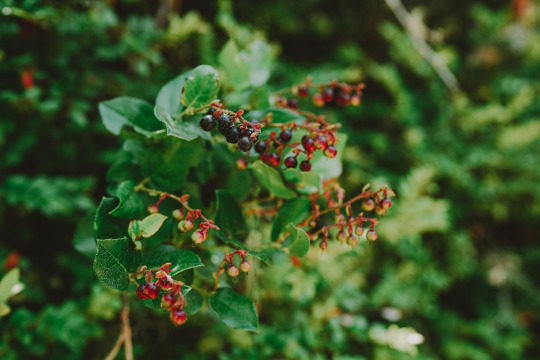
Yesterday's bugs and berries. I know the berries, for the most part; can someone help with critter IDs?
#thimbleberry#huckleberry#vaccinium ovatum#Rubus parviflorus#possibly: Rubus ursinus (blackberries are hard)#Gaultheria shallon#salal#blackberry#berries I ate#nothing better than eating a berry off a bush on a long walk#digital photography#sonya7r4#sonya7riv#photographers on tumblr#color photography#photography#photographers of tumblr#original photography#flora#green#fauna#lensblr
9 notes
·
View notes
Text
Rubus and vaccinium r lesbians & in love fyi
2 notes
·
View notes
Text
best berries in the world!
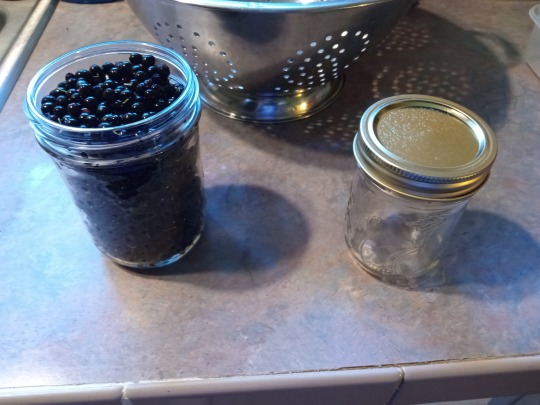
I'm not sure which species but I think they're evergreen huckleberries (Vaccinium ovatum) according to wikipedia
#i have no idea what the Salish word for these fruit are#According to my Indigenous knowledge textbook “Lighting the Eighth Fire” I think their called a word my fucking keyboard won't type#it looks like “lawiyal” but the L's have two dashes through them
2 notes
·
View notes
Text
Next up is Vaccinium ovatum, in the ERICACEAE family. Its common name is evergree huckleberry!
This evergreen shrub can be identified by its alternate, ovate leaves with serrulate margins. The new growth has a red color, and the branchlets are reddish as well. Its urn-shaped flowers are white or pink and occur in clusters of 3-10 in the leaf axils. It produces shiny, round berries that are black when ripe.
Vaccinium ovatum is native from British Columbia to California, commonly in the edges and openings of coniferous forests. It can grow in either shade or full sun. It can grow in very nutrient poor soils thanks to its mycorrhizal fungus associations, which also aid in the intake of water. Well established plants can recover from fire by resprouting from their root crown.
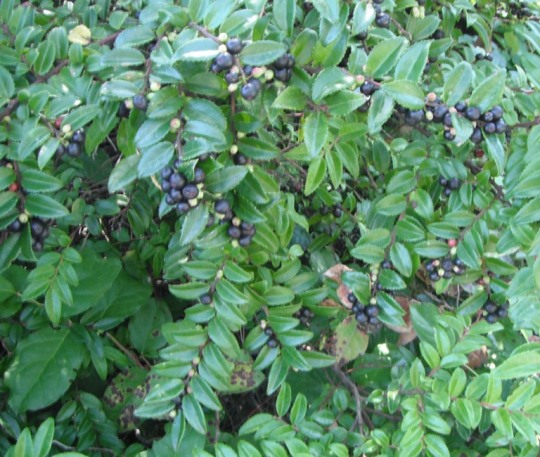

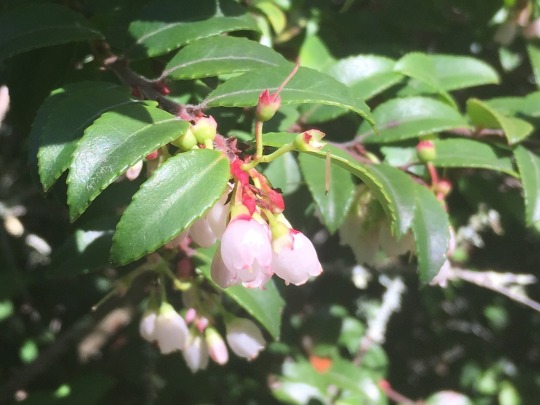
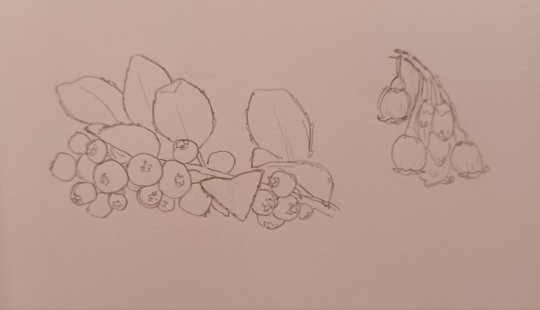
0 notes
Text
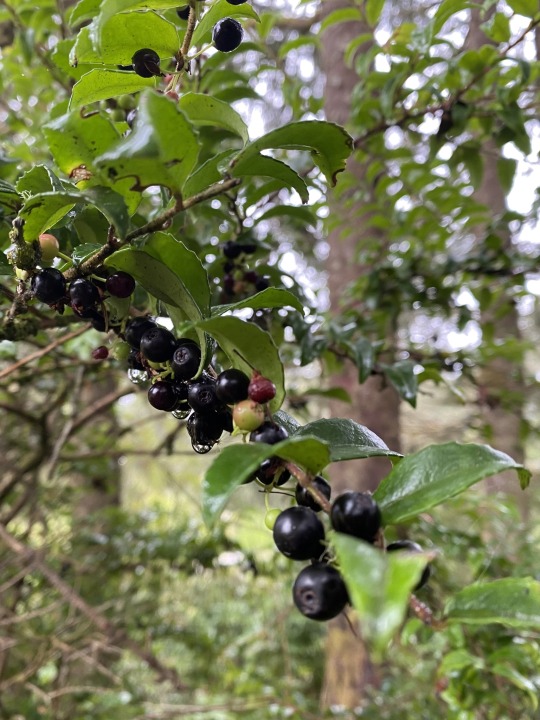
Evergreen huckleberry…Vaccinium ovatum…
124 notes
·
View notes
Photo

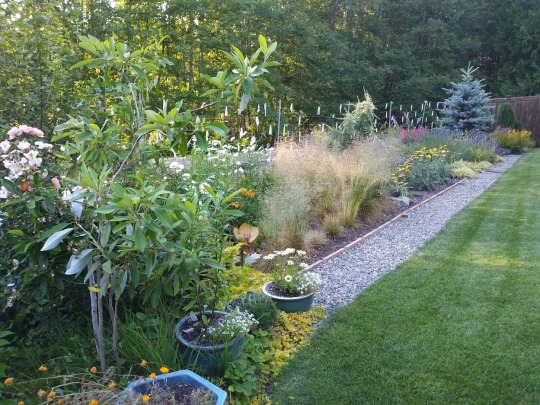
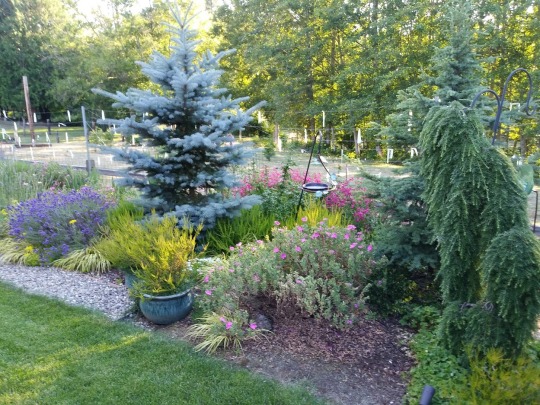

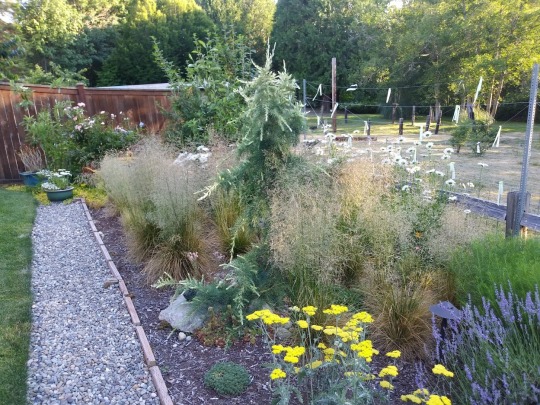

Our BACK Garden - many photos have been posted featuring the small Flower Garden on the south side of the house. This posting is for the entire BACK Garden, just an overview.
1. The back of our house, which faces due west. Photo taken last evening from the Upper Meadow part of our neighborhood forest restoration project. That’s the Back Porch up above, beneath which is a bench seat, shade garden, and a bunch of pots. On the right up against the wall is the Flower Garden. And, in front, behind the split-rail fence that separates all our homes from the forest project, is the “Back Garden”.
2. Overall view of the Back Garden, 60′ x 10-12′ extending south to north along the west side of the lot. That’s a gravel Infiltration Trench along the inner side, which collects rainwater from the roof and allows it to soak into the groundwater table. The CONCEPT of the Back Garden was developed by both of us, working together for a change, just as we did with the Japanesque Front Garden. The idea was to create a garden that related to the meadow beyond the fence, but that could also house a number of larger plants we brought from our former home in Bothell, WA. So it starts at one end with a riparian zone, spreads into a prairie, that interblends with Mediterranean plants, and ends in an alpine zone.
UPPER - the “Alpine” features a smaller-growing Baker’s Colorado blue spruce (Picea pungens ‘Bakeri’), a light green Mountain hemlock (Tsuga mertensiana), and an upright-trained ‘Thorson’s Weeping’ Western hemlock (Tsuga heterophylla cultivar). There are also shrubs: colorful-foliaged summer heathers (mainly Calluna vulgaris ‘Firefly’), a rockrose, several smaller growing forms of mahonia, a Himalayan blueberry, a Crandall currant (fragrant, yellow-flowered hybrid of the Intermountain West native Ribes odorata), HUGE bushy hybrid penstemon - Garnet and Firebird, and underneath the hemlocks - the tall ground-cover Big Sur manzanita (form of Arctostaphylos edmundsii).
UPPER MIDDLE - the “Mediterranean” features magenta-flowered Sunset rockroses (Cistus x pulverulentus), various English and French lavenders, a mass of chrome yellow Moonshine yarrow, and a mass of variegated purple moor grass (Molina caerulea ‘Variegata’) interplanted with various crocosmias.
MIDDLE - the “Prairie” - this is the largest part of the garden, melding into the Mediterranean garden on the north. This features double curving bands of Rudbeckia fulgida ‘Early Bird Gold’ and Becky Shasta Daisy, clumps of standard purple moor grass, white yarrow, purple Verbena bonariensis, Russian sage (Perovskia atriplicifolia), a whale-shaped mass of variegated Northern hairgrass (Deschampsia caespitosa), blending into a mass of billowing Arkansas blustar (Amsonia hubrechtii). And...at the juncture with the Mediterranean garden is a “weeping” Deodar cedar, probably Snow Sprite, planted in a mound of rocks with penstemon, sedums, and sempervivums.
Interesting story here - this was originally an upright “tree”, planted on the hill above our Bothell house. One summer the top was whacked off during routine blackberry and Scotch broom control. But one horizontal branch was left. So, in 2018, I dug it up and brought it with us, intending it to be an interesting “bonsai” in the garden. Well, the plant had other ideas. In 2019, the horizontal branch started to rise skyward - that’s right - during the summer of 2019, we watched as it went from horizontal to diagonal 45 degree angle. By 2020, that horizontal branch cranked itself to a 90 degree angle and had become a tree trunk, pointing directly up. SHOCKED!
SOUTH END - the “Riparian Zone” - shown partially in the Overall and view of the prairie. This features a blue hydrangea, grown from a shoot off a hydrangea in our very first garden in Atlanta in 1995, an big bushy Amber Flower Carpet rose, a volunteer native pink-flowering currant (the BIG bush - Ribes sanguineum), a pair of evergreen, upright, willowy, multi-stem Sweetbay magnolias - (Magnolia virginiana Jim Wilson MOONGLOW), a native evergreen huckleberry (Vaccinium ovatum), and an assortment of perennials, including: Jupiter’s Beard (Centranthus ruber), Baptisia, foxgloves, various different crocosmias, Salvia nemerosa, and Geum x Tangerine.
Well that’s the Intro folks - I will feature each of the plants over the next couple of years. Cheers on this 245th anniversary of the independence of the USA, as it became known.
3 notes
·
View notes
Text
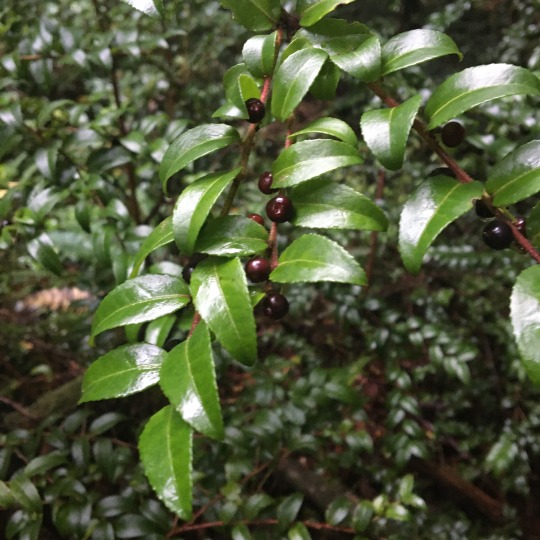
Vaccinium ovatum, evergreen huckleberry, winter huckleberry, California huckleberry
8 notes
·
View notes
Text
Life, thriving, in temperate rainforest canopies. Up there, in the branches, in the sky: Slugs, snails, crustaceans, mosses, lichens, mushrooms, even huckleberry and elderberry, hundreds of feet above the forest floor. An oasis in the sky. Fern mats in the canopy of a single tree may have a soil substrate a meter deep, and hold thousands of liters of water. Maybe this isn’t surprising, for such a fertile ecoregion. Though, something about the temperate rainforest canopy that might be surprising? The “sky salamander.” Rinforest creature, a lover of fog. They’re only in the Pacific Northwest, of course. A cryptic presence. Weirdly, there are two separate populations of this salamander, with a great distance between them. Some of these salamanders live in the rainforest of Vancouver Island. But the other population? In the redwoods forest of coastal northern California, the salamanders also permanently reside up to 95 meters above ground in the canopies of redwoods, where moss beds and epiphytic fern mats, resting in bark crevices and on redwoods branches, create refuge and provide small amphibian-friendly microhabitats in the sky. They can spend their entire life up there, in the fog. (Tree-sitters, trying to interrupt industrial timber harvest, were some of the first people to notice that the salamanders are a regular resident of the canopies.) To me, at least, the canopy seems such a cool place to live, especially for a type of creature usually associated with rotting logs on the forest floor.
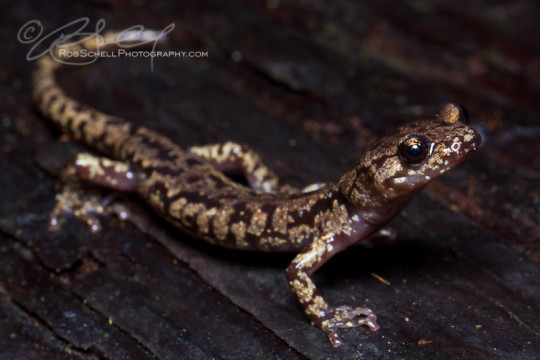

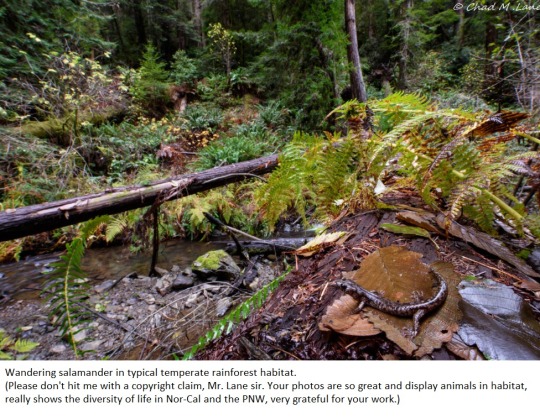
One of my favorite amphibians? Aneides vagrans, the “wandering salamander.” I don’t like that English common name, and so I reject it. I prefer “sky salamander.” For me, two extraordinary aspects about the creature. [1] The species has a very weird disjunct distribution range, with two isolated populations, one living in the redwood forests of northern California’s coast. And a separate population living … on Vancouver Island, but in none of the rainforest in Oregon and Washington in between these two populations. Why the separation? (More on that below.) And [2] some individuals will permanently occupy habitat 300 feet off the ground in the canopies of redwoods, where epiphytic mosses and fern mats, resting on branches, absorb moisture like a sponge creating little microclimates, providing the salamanders with year-round refuge. It’s likely that at least some of the salamanders are born, live, and reproduce - spending their entire lives - in the canopy.
Here’s a look at an epiphytic fern mat in a redwood canopy, where wandering salamanders dwell.
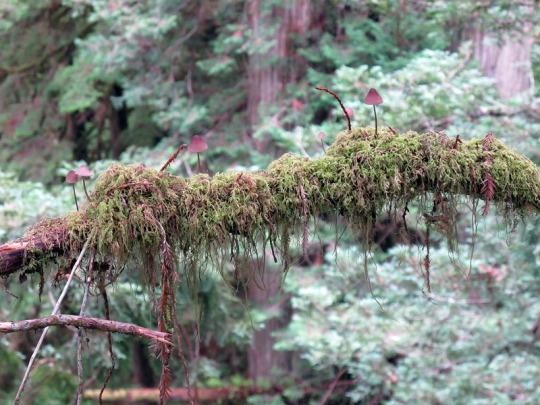
Here she is. [These 2 photos by G.Nafis, via their site, California Herps.]
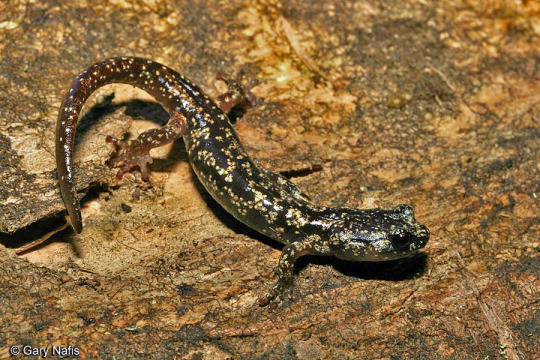

The salamanders are fully terrestrial. Their eggs are laid on land, and their young hatch with morphology similar to adults. In other words, there is no aquatic larva stage where the juvenile has gills and must be submerged in water. This probably contributes to the salamander’s ability to live its entire life in a tree, without needing to find a pool of water on the forest floor to lay eggs and metamorphose.
What are salamanders doing in the redwood canopy?
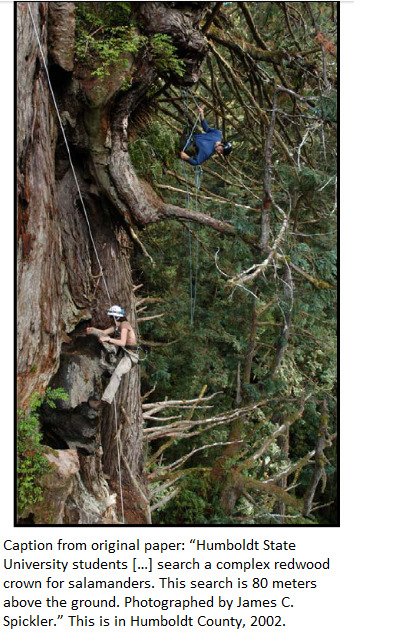
Excerpt from: Jim Campbell-Spickler and Stephen C. Sillett. Remote camera monitoring and a mark – recapture study of the wandering salamander in a redwood forest canopy (2017).
Crowns of old redwoods (Sequoia sempervirens (D. Don) Endl.) are teaming with life. Storm damage followed by recovery via trunk reiteration increases the structural complexity of redwood crowns over time. Bark and wood surfaces within complex redwood crowns accumulate debris and become covered with epiphytes. Arboreal soils develop beneath mats of the leather-leaf fern, Polypodium scouleri, and within pockets of decaying wood colonized by the evergreen huckleberry, Vaccinium ovatum, promoting water storage and allowing desiccation-sensitive creatures to flourish high above the ground. These habitats provide year-round refugia for insects, mollusks, and vertebrates like the wandering salamander (Aneides vagrans). [End of excerpt.]
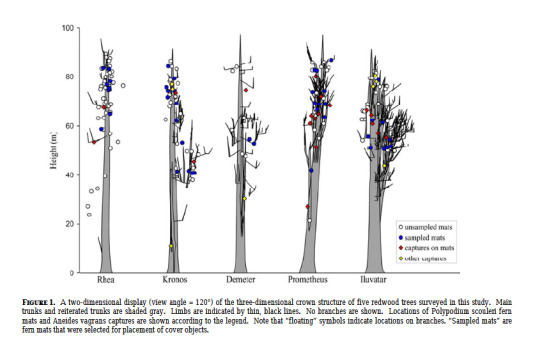
Locations where salamanders were tagged in the canopies off 5 separate redwood trees.
Here’s another paper on the salamanders in the trees: James C. Spickler, et al. Evidence of a new niche for a North American salamander: Aneides vagrans residing in the canopy of old-growth redwood forest (2006). Excerpt:
Salamander observations were made by non-scientists illegally occupying trees to protect them from logging. In the spring of 2002, an activist designated as [X] began a tree-sit on private timber lands. [X], along with other activists, established sleeping platforms in several large redwoods near Freshwater, in coastal Humboldt County, California. [X] remained aloft for nearly a year before being forcibly removed and arrested for trespassing. In that time period she made numerous observations of a pair of wandering salamanders. [...] On seven occasions from April to September, [X] observed the “same pair” of wandering salamanders moving within an area around a small cavity located 3 meters from her living platform. The loss of the leader occurred at least 100 years before, and two reiterated trunks had replaced it. [D]ecaying wood had formed around the break created the cavity that the salamanders occupied. […] Most of the salamander activity was limited to the area on and around the fern mat, but on two occasions a salamander moved out along branches and continued to the outer crown where it could no longer be seen.
Similar observations were made by another activist, [Y], participating in a tree-sit in the Van Duren watershed in Humboldt County. [...] On 17 September 2002 at 0800 hrs, one of us and his graduate student observed an adult A. vagrans while crown-mapping a large redwood in Humboldt Redwoods State Park. We observed a single adult A. vagrans moving vertically along the trunk at a height of 93 meters above ground.
We also have made incidental observations of A. ferreus, a close relative of A. vagrans. In 1993, Stephen Sillett observed an A. ferreus while conducting canopy research in a 700-year-old Douglas-fir forest (Middle Santiem Wilderness Area, Willamette National Forest, Willamette County, Oregon; see Sillett 1995). While climbing in a large Douglas-fir tree adjacent to a 30-year-old clearcut, he found an adult salamander under moss (Antitrichin curtipendula) on a large branch approximately 30 meters above ground.
[End of excerpt.]
Why the weird distribution range?
Here’s where the sky salamander species (Aneides vagrans) lives. (Sorry for the shitty map, I used M!crosoft Paint, henceforth: “the working-class Arc-GIS.”)
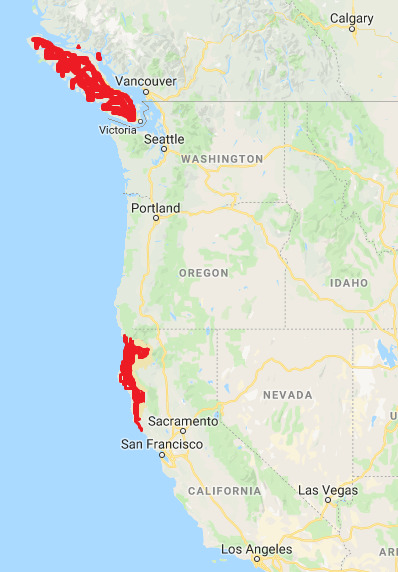
So, if this is a coastal rainforest species, why are they living in rainforest of northern California and in the rainforest of Vancouver Island, but not in all that rainforest in between? Perhaps it’s because the ecological niche for a semi-arboreal rainforest-dwelling Aneides salamander is already filled in Oregon’s rainforest, by the species Aneides ferreus (clouded salamander).
Some US universities and academics suggest that the wandering salamander was recently and accidentally introduced to Vancouver Island via human activity, that the wandering salamander is a “non-native species” on Vancouver Island. Apparently the most popular theory, in US institutions, is that the tanoak trade in the late 1800s inadvertently carried salamanders (hiding in the bark) during ocean shipment to processing locations on Vancouver Island. Tanoak was harvested in northern California and shipped to the island. Therefore, some US ecologists recognize the wandering salamander as a recent presence and an introduced species on Vancouver Island.
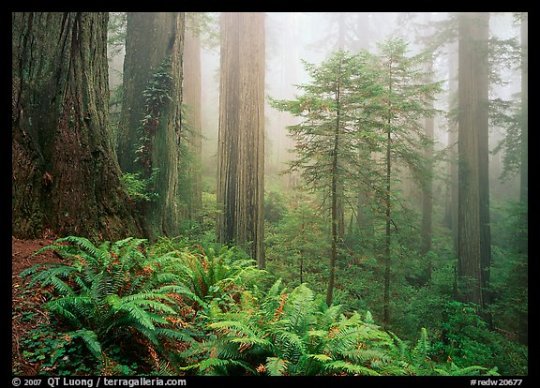
On the other hand, some Canadian biologists and other researchers dispute this theory, instead suggesting that the salamander made its way to Vancouver Island without human assistance - probably by rafting on the thousands of enormous conifer logs that fall into northern California’s coastal waters and flow northward along the coast towards the Raincoast and Vancouver Island. More evidence for this natural dispersal, say Canadian scientists, is that wandering salamanders were already being reported by surveyors deep in old-growth forests on Vancouver Island within only a few years of the beginning of the tanoak trade. These sightings were happening in forest on far corners of the island and in remote watersheds very far away from any tanoak, shipment sites, harbors, or European/white residents. Additionally, even in the early days of the tanoak trade, the wandering salamander was apparently already present on tiny little islands in the Salish Sea off the coast of Vancouver Island.
So, make of that what you will. A mystery. [I have sources, including from the Canadian federal government’s SARA Registry research, that describe this debate and possible natural scenarios for salamander’s arrival on Vancouver Island, if anyone wants to look more deeply into it.]
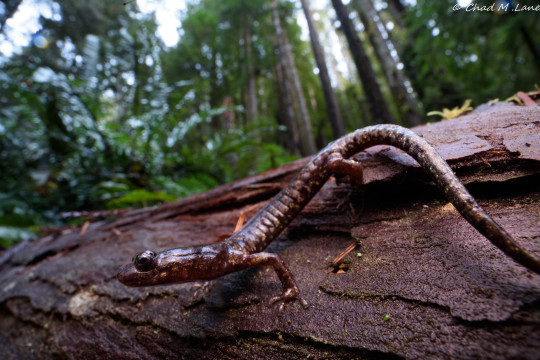
Sky salamander.
300 feet above the forest floor, in the rain and mist and fog, an entire network of mosses and insects and ferns and molluscs spending their life in the sky.
170 notes
·
View notes
Text
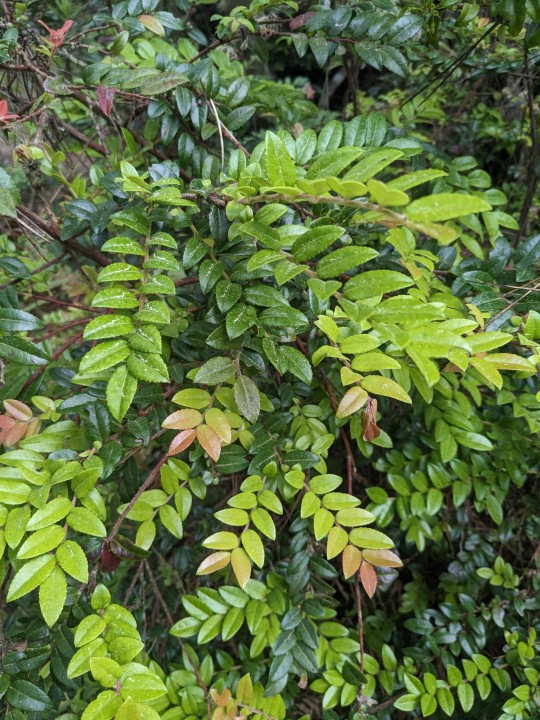
Vaccinium ovatum
8 notes
·
View notes
Photo
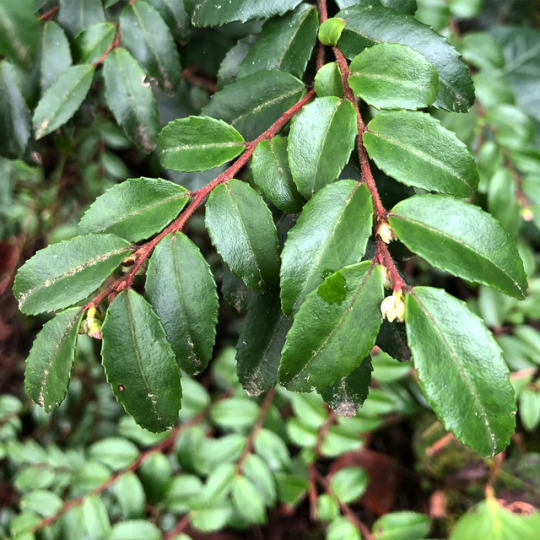
I can’t be the only one who thinks these little leaves are adorable, right? 🌸 and the flowers are just about to bloom! 🌿 Evergreen Huckleberry, Vaccinium ovatum. Ericaceae family. #vaccinium #vacciniumovatum #evergreenhuckleberry #ericaceae #botany #plants #pnw
18 notes
·
View notes
Text
Brian Minter: High antioxidant plants can thrive in our climate
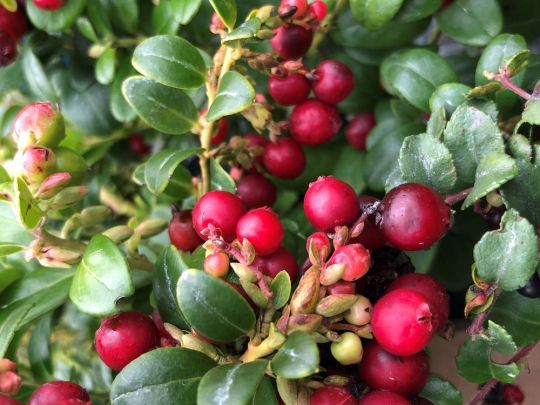
As the interest in growing our own food keeps expanding we are, unfortunately, overlooking some of the healthiest and most beautiful fruits of all. We may have a few blueberry plants in our gardens, but their more powerful, high antioxidant cousins, are seldom planted.
The vaccinium family is, without a doubt, a leading health food series of plants. Cranberries (Vaccinium macrocarpon) are a prime example. In her book, The Beauty of Berries, author Lisa Petty, a renowned nutritionist, points out their amazing qualities in terms of health benefits. She also explains how they are helpful in preventing kidney stones, tooth decay and dental plaque and are also proving useful in the fight against cancer because they help impede the process that feeds cancer tumours.
Hardy to zone 4, cranberries are not necessarily bog plants but will thrive in good quality, well-draining soil. Growing about eight to 10 inches tall, cranberry plants spread out as thick mats, making them a great option for an evergreen ground cover. Their beautiful bronze winter foliage is particularly attractive.
Hundreds of very tiny flowers in spring turn into huge, deep red berries in fall. I know from personal experience that a few frosts will bump up their brix sugar measurement so they will taste far less tart when eaten. According to Petty, cranberries are one of the best whole foods and have a great fibre content.

Lingonberries (Vaccinium vitis-idaea) are native plants growing in many parts of Canada and the U.S. Extremely popular in Europe, many hybridized varieties are grown on a massive scale. A high antioxidant berry, they are used in preserves, jams, jellies and sauces, and, like cranberries, lingonberries are used in the baking industry. In Scandinavian countries and in Germany, they are grown both commercially and as a popular plant in home gardens.
Vaccinium ‘Koralle’ is a lingonberry that originated in Germany and grows about 15 inches tall and wide. It is one of the main cultivars in both old and newer plantings. It has a medium to large sized berry with a tart to sweet flavour.
Vaccinium ‘Red Pearl’, a lingonberry that grows a little larger (up to 18 inches tall and wide) has medium to large berries that have a sweet acidic flavour. On average, each mature plant will produce about one to one-and-a-half pounds of berries.
I think lingonberries are an important missing element in many gardens. They require excellent drainage to prevent root rot or phytophthora. To keep the soil open and porous, I always mix a fifty per cent ratio of fine fir or hemlock bark mulch into each planting hole. Lingonberries are evergreen, have a long blooming season and their red berries begin to form in mid to late summer, making them extremely colourful.
They have many of the same medicinal properties as their cranberry cousins, but because of the challenges of harvesting them on a larger scale, they are less well known. In the garden, however, they are a ‘must have’.
Vaccinium parvifolium is a deciduous, tall-growing variety of huckleberry found anywhere from the Sierra Nevada in California up to Alaska. It has showy, tasty red berries that are ideal for jellies and jams. It loves shade but unfortunately does not make a great garden specimen.

Known as the ‘evergreen huckleberry,’ Vaccinium ovatum, however, makes a wonderful garden plant. Native from Santa Barbara in California and up along the B.C. coast, it is a hardy zone 4 plant. When grown in a sunny location, it can measure three feet tall and wide, but in a natural shady spot, it will reach up to ten feet. It has small, glossy foliage, and it too has white flowers in spring. It forms black berries in late summer that last, like lingonberries, well through the winter. Its berries are tart tasting, but, like cranberries, they will sweeten nicely with subsequent frosts. Looking fabulous all year round, it belongs in any area where azaleas and rhododendrons would flourish, and like its other vaccinium cousins, it needs very good drainage.
A huckleberry variety called ‘Thunderbird’ is the product of a former plant introduction program from the University of British Columbia. It has all the medicinal properties of cranberries and lingonberries, but it is seldom seen commercially, again because of the harvest challenges of small berries.
All of these vacciniums are excellent when used in containers — they are evergreen and attractive year-round. They love the same acidic soils that have bark blended in the mix, and they need just a little slow-release fertilizer to keep them looking their best. I often plant them with winter-flowering heathers, not only for the added beauty, but because, when the heathers bloom in mid-spring, they attract pollinators that fertilize the vaccinium flowers. We can easily make our containers and gardens healthier and more attractive by planting those forgotten favourites, vacciniums.
Brian Minter: High antioxidant plants can thrive in our climate published first on https://weedkillerguide.tumblr.com/
0 notes
Photo
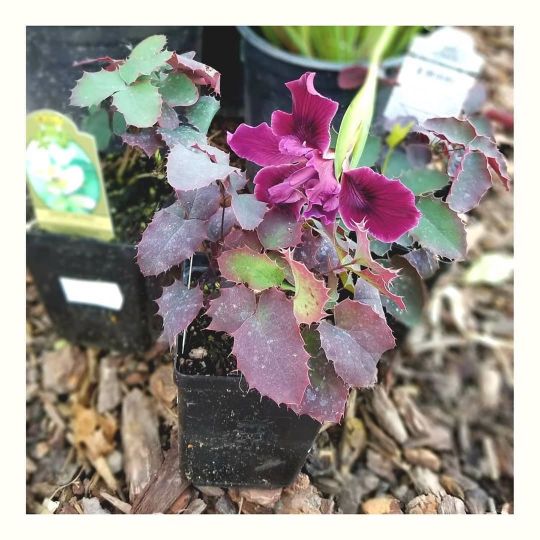
#Repost @nguyenmusto.artworks ・・・ So what does a stay-at-home landscape architect do when she's still trying to figure out how to best deal with a pandemic and is trying to refresh her artist mojo? She goes gardening! Before the California shutdown orders, I went to a few of our locally-owned nurseries to hoard native plants for my home pollinator garden rehab. Good thing I did! When I went back few days later, the native plant inventory was pretty lean. For some shelter-in-place native plant inspo, here are a few snaps of some of my new plants and current spring blooms for a shady courtyard garden. 📸: Creeping Oregon Grape (Berberis repens) & Pacific Coast Iris 'Purple' fresh from the nurseries - #fairoaksboulevardnursery and #plantfoundry 📸 Pacific Coast Iris closeup - still blooming 2 weeks after purchase and planting! 📸 Huckleberry (Vaccinium ovatum). In the ground since last spring. Maybe I'll get some berries this year. 📸 Dutchman's Pipevine (Aristolochia californica). Planted this in January in 2 large pots with tuteurs that flank the entry to the house. I hope to get blooms next February! If it's robust enough next year, I may bring home pipevine swallowtail caterpillars. 📸 Wild Ginger (Asarum caudatum). Roots are supposedly edible. I need to do more research. 📸 Perfume Catalina (Ribes viburnifolium). Leaves have a wonderful fragrance. 📸 California Bush Anemone (Carpenteria californica 'Elizabeth') - ready to pop! I have this smaller variety growing in 2 large pots that flank the gate. I'll have more snaps to share in the coming days. #staysafe #coronavirusgardening #californianativeplants #oregongrape #pacificcoastiris #huckleberry #dutchmanspipevine #wildginger #perfumecatalina #californiabushanemone #californiaspring #shadegarden #habitatgarden #littlejoys https://www.instagram.com/p/B-pzx9eppnA/?igshid=fhb4q3hj58sp
#repost#fairoaksboulevardnursery#plantfoundry#staysafe#coronavirusgardening#californianativeplants#oregongrape#pacificcoastiris#huckleberry#dutchmanspipevine#wildginger#perfumecatalina#californiabushanemone#californiaspring#shadegarden#habitatgarden#littlejoys
0 notes
Video
J20170817-0026—Vaccinium ovatum var saporosum—RPBG by John Rusk
Via Flickr:
Vaccinium ovatum var. saporosum—pear-shaped huckleberry. The variety saporosum has been lumped into the species by both The Jepson Manual, 2nd ed., and the Flora of North America. Variety saporosum differs a bit from the species by its pear-shaped fruit. W. L. Jepson wrote that the variety matured a bit earlier than the species and had a better flavor. Huckleberries are certainly one of the best tasting of all California native berries Those interested in culinary uses should visit the link on the CalFlora.org page for Vaccinium ovatum. The link contain several recipes for huckleberries. Photographed at Regional Parks Botanic Garden located in Tilden Regional Park near Berkeley, CA.
#ebparksok#taxonomy:kingdom=Plantae#Plantae#taxonomy:subkingdom=Tracheophyta#Tracheophyta#taxonomy:phylum=Magnoliophyta#Magnoliophyta#taxonomy:class=Magnoliopsida#Magnoliopsida#taxonomy:order=Ericales#Ericales#taxonomy:family=Ericaceae#Ericaceae#taxonomy:genus=Vaccinium#Vaccinium#taxonomy:species=ovatum#taxonomy:binomial=Vaccinium ovatum#taxonomy:trinomial=Vaccinium ovatum saporosum#Vaccinium ovatum saporosum#Fruit#Berry
0 notes

